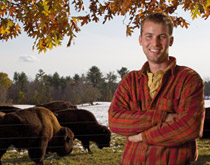
Christopher Gallot’s life is going according to plan. Since the architecture major earned his degree from Carnegie Mellon in 2010, he has been working for an established architecture firm in Boston. No surprise. But as he and a childhood friend, Conor Guptill, finish a six-pack of Sierra Nevada lager one night, he reveals an alternative plan that includes quite a surprise—quitting his job, moving out West, and making his way back to the East Coast by working at buffalo farms and, when necessary, living out of a tent.
Huh?
He tells Guptill that the inspiration came, in part, from That Old Ace in the Hole, by Annie Proulx, a Pulitzer Prize-winning novelist. The story details how local farmers resist the temptation to sell out to a corporation. Throughout the pages, Proulx portrays buffalo as animals that, unlike cows, head into a storm rather than away from it, so they can weather the rain more quickly.
Gallot highlighted this passage in his copy of the book: Now the buffs, they evolved on the plains with the plants—the two grew up together. They belong together in this place, this landscape.
Guptill interrupts his friend. He doesn’t take issue with Gallot’s obsession with buffalo, or the insanity of the idea, just the timeline. He points out to Gallot that his family has 150 acres of farmland in their hometown of Berwick, Maine, which has been in his family since before the signing of the Declaration of Independence.
“Why don’t we revitalize it?” Guptill asks.
“I came to the conclusion that, yeah, I could start my cross-country journey, then maybe years down the road, use the knowledge to start my own farm,” Gallot says. “Or we could team up now, get down in the dirt, and make it happen.”
Both decided to make it happen.
Within months, using equipment borrowed from neighboring farmers, they dug holes for posts and built a fence to pasture the animals and a corral to sort them. Then, after some research and guidance from nearby bison ranchers, they began herding buffalo on their ranch last May. The pair has successfully created a New England prairie that they’ve christened the Bison Project.
In its design, Gallot says, he put his sustainable architecture schooling to good use, just not for bricks and mortar. “Architecture, to me, is much broader than buildings.” He points out the project’s four components:
- Sustainability: raising grass-fed bison that will give customers a local food alternative to industrial food sources
- Conservation: taking over underutilized farmland and putting it to use, perhaps even leasing pastures, so the land doesn’t entice shopping mall or housing developers
- Education: on-site classes about sustainable food production, balanced ecosystems, and traditional farming
- Community: regular “Jubilee Gatherings” that bring together artists and musicians with co-op exchanges and food pot-lucks.
“That’s the larger idea,” says Gallot, “fostering social, community-driven projects. I wish there was more of that being done everywhere.” Spoken like a character out of Proulx’s novel.



